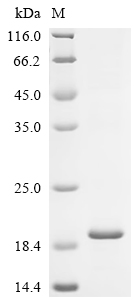Recombinant Mouse Transient receptor potential cation channel subfamily V member 4 (Trpv4) , partial
CAT:
399-CSB-EP875332MO4e1-03
Size:
20 µg
Price:
Ask
- Availability: 24/48H Stock Items & 2 to 6 Weeks non Stock Items.
- Dry Ice Shipment: No




Recombinant Mouse Transient receptor potential cation channel subfamily V member 4 (Trpv4) , partial
- CAS Number: 9000-83-3
- Gene Name: Trpv4
- UniProt: Q9EPK8
- Expression Region: 723-871aa
- Organism: Mus musculus
- Target Sequence: GQVSKESKHIWKLQWATTILDIERSFPVFLRKAFRSGEMVTVGKSSDGTPDRRWCFRVDEVNWSHWNQNLGIINEDPGKSEIYQYYGFSHTVGRLRRDRWSSVVPRVVELNKNSSADEVVVPLDNLGNPNCDGHQQGYAPKWRTDDAPL
- Tag: Tag-Free
- Source: E.coli
- Field of Research: Neuroscience
- Assay Type: In Stock Protein
- Relevance: Non-selective calcium permeant cation channel involved in osmotic sensitivity and mechanosensitivity. Activation by exposure to hypotonicity within the physiological range exhibits an outward rectification. Also activated by heat, low pH, citrate and phorbol esters. Increase of intracellular Ca (2+) potentiates currents. Channel activity seems to be regulated by a calmodulin-dependent mechanism with a negative feedback mechanism. Acts as a regulator of intracellular Ca (2+) in synoviocytes. Plays an obligatory role as a molecular component in the nonselective cation channel activation induced by 4-alpha-phorbol 12, 13-didecanoate and hypotonic stimulation in synoviocytes and also regulates production of IL-8. Together with PKD2, forms mechano- and thermosensitive channels in cilium. Promotes cell-cell junction formation in skin keratinocytes and plays an important role in the formation and/or maintenance of functional intercellular barriers. Negatively regulates expression of PPARGC1A, UCP1, oxidative metabolism and respiration in adipocytes. Regulates expression of chemokines and cytokines related to pro-inflammatory pathway in adipocytes. Together with AQP5, controls regulatory volume decrease in salivary epithelial cells. Required for normal development and maintenance of bone and cartilage. In its inactive state, may sequester DDX3X at the plasma membrane. When activated, the interaction between both proteins is affected and DDX3X relocalizes to the nucleus.
- Purity: Greater than 85% as determined by SDS-PAGE.
- Activity: Not Test
- Length: Partial
- Form: Liquid or Lyophilized powder
- Buffer: If the delivery form is liquid, the default storage buffer is Tris/PBS-based buffer, 5%-50% glycerol. If the delivery form is lyophilized powder, the buffer before lyophilization is Tris/PBS-based buffer, 6% Trehalose, pH 8.0.
- Reconstitution: We recommend that this vial be briefly centrifuged prior to opening to bring the contents to the bottom. Please reconstitute protein in deionized sterile water to a concentration of 0.1-1.0 mg/mL.We recommend to add 5-50% of glycerol (final concentration) and aliquot for long-term storage at -20℃/-80℃. Our default final concentration of glycerol is 50%. Customers could use it as reference.
- Molecular Weight: 17.3 kDa
- Storage Conditions: The shelf life is related to many factors, storage state, buffer ingredients, storage temperature and the stability of the protein itself. Generally, the shelf life of liquid form is 6 months at -20℃/-80℃. The shelf life of lyophilized form is 12 months at -20℃/-80℃.
